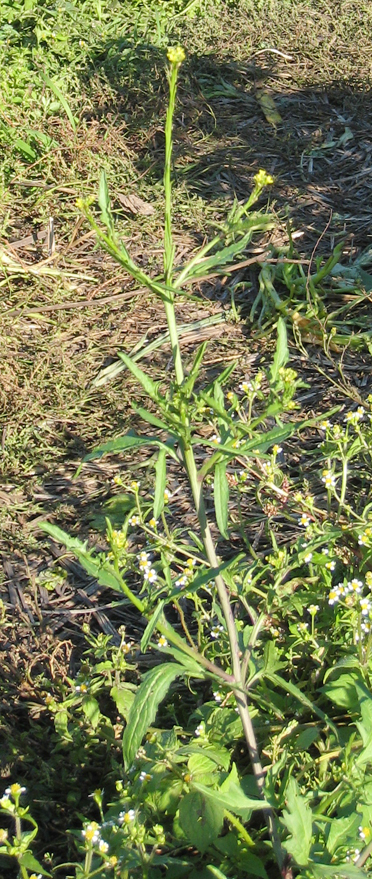
|
| Hedge Mustard; Sisymbrium officinale (L.) Scop. |
Mustard Family; CRUCIFERÆ (BRASSICACEÆ)
|
| How's this for an engaging introduction: Hedge Mustard is a poor flavored, ugly pest. Regrettably, it is too common to ignore
--much more abundant than Field Mustard, its superior cousin (October 1987 weed article). Ordinary Brassica mustards grow in fields and loose soil. Hedge Mustard was named since it can thrive in harder ground, and shadier sites, such as hedgerows. It loves unweeded
gardens and can grow six feet tall, gradually becoming a tumbleweed. No other of our common weeds is so tumbleweedy in shape; the
stems curve and arch in varied directions as they lengthen and dry during the summer. Born in the fall or spring, the plant dies at the end
of summer. |
| Except when Hedge Mustard is a lush young plant in spring, it is scrawny and conveys a misery image; it begs to be
despised. The dandelion-yellow flowers, no bigger than need be, are crudely congested at the tips of wiry branches. The stems are
often purplish. In the summer it can get dusty looking. It has not, in brief, the appearance of a plant you'd welcome to your garden. As
it ages its narrow, pointy seedpods, short and pressed tightly to the branches, turn blackish and release their prodigious quantities
of seeds. |
| Curiously, despite looking like a weak, malnourished plant, Hedge Mustard actually has the last laugh. For it is biologically
very successful. Humans excepted, beauty counts for less than talent in Nature's pageant, and mere charm in no way counts. So
some plants can be ugly yet abundant, and yet many we term lovely are weak, rare things. |
Maude Grieve, (1931, A Modern Herbal), relates how "This plant is named by the French the Singer's Plant, (Herbe au
Chantres) it having been considered up to the time of Louis XIV an infallible remedy for loss of voice." Other French names are Tortelle,
and Julienne Jaune. Are your tastebuds are more accommodating than mine? If so, eat Hedge Mustard greens raw or cooked. I find
too many tastier edibles where this weed grows to bother eating it.
|
Originally published as the Seattle Tilth newsletter Weed of the Month in Aogust 1992, along with an illustration from a book.
Back |
|
|

